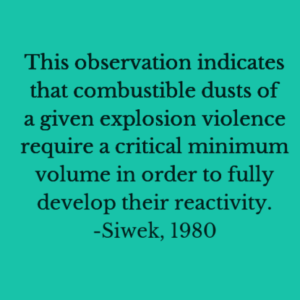1-Sentence-Summary: A small laboratory scale apparatus is designed to replicate testing results from the larger 1-m3 chamber historically used to characterize explosive dusts.
Authors: R. Siwek
Read in: Three Minutes
Favorite quote from the paper:

The current author completes an experimental research program to design a small scale explosion testing chamber that can replicate the results from the larger 1-m3 chamber. Over 10,000 individual tests are completed using 50 different dusts from industry. The goal of the program is to determine the smallest volume needed to accurately replicate the volume normalized maximum rate of pressure rise from the 1-m3 vessel (\(K_{St} = [dp/dt]_{max}^{1/3}\), also called explosion index).
Experimental tests are completed in 1.3, 5, 10, and 20 liter spherical chambers. The results are presented in terms of pressure-time plots, summary of maximum pressure and explosion index verses dust concentration, and comparison between parameters determined in the 1-m3 and other vessels.
The 20-L spherical chamber with a dispersion ring is shown to slightly under predict maximum pressure, but to match the explosion indices of the 1-m3 chamber. The comparison is found to be independent on ignition energy and to hold up to rapid aluminum dust explosions of 700 bar-m/s.
Three of the main findings from this paper are:
- The dispersion system plays an important role in explosion measurements.
- Vessel volume limits the maxim KSt values that can be measured in a given apparatus.
- Vessel surface-to-volume ratio alters the slope of the ‘cubic relation’ between the 1-m3 chamber and the given apparatus.
The following sections outline the main findings in more detail. The interested reader is encouraged to view the complete article at the link provided below.
Finding #1: Dust dispersion is an important experimental parameter
The author finds that the dispersion system plays an important role in the explosion measurements. With the 5 and 10 liter chambers a ring nozzle compared the most favorably with the 1-m3 chamber. A ball nozzle and a mushroom cap nozzle compared less favorably.
For the final 20-L chamber the original ring nozzle also proved unsatisfactory. A modified ring nozzle was developed which wraps around the walls of the chamber. This extended ring nozzle was used for the final comparisons between the 20-L and 1-m3 chambers. Little discussion is given for the reasoning behind the discrepancies with different dispersion systems.
Finding #2: Vessel volume limits maximum KSt that can be measure
The author plotted the deflagration indices in each vessel compared to the 1-m3 chamber. The plots showed a linear increase between the two chambers up until a maximum value. After the maximum value the deflagration index in the smaller chamber ceased to increase.
The maximum KSt values in the 1.3, 5, and 10 liter vessels were approximately 70, 350, and 500 bar-m/s, respectively. Linearly extrapolating these limiting values to 20-L chamber results in approximately 1000 bar-m/s. Experimental dusts up to 700 bar-m/s compared well to the 1-m3 chamber.
Finding #3: Vessel surface-to-volume ratio governs the agreement between vessels
Although the comparison between deflagration indices in each vessel and the 1-m3 chamber were linear, the slope for each vessel was different. This slope increased to perfect agreement as the vessel size was increased. In other words KSt,vessel/KSt,1m3 approached 1.0 as the vessel size increased.
The author plotted the linear slope against the surface-to-volume ratio of each vessel and demonstrated a linear relationship between the two. From extrapolating this linear relation a minimum volume of 16.1 L was found. The authors suggest that this surface-to-volume ratio is required for the dust to “fully develop its reactivity”.
My Personal Take-Aways From
“Experimental Methods for the Determination of Explosion Characteristics of Combustible Dusts”
This paper is an important contribution to the literature as it forms the basis for the experimental equipment that is still used today. Unfortunately, the paper is very difficult to find and a link to an electronic copy could not be accessed. Furthermore, the original work is based on the thesis of Richard Siwek which does not appear to have an English translation. Fortunately, the figures are reproduced in the textbook of Bartknecht (Explosions: Course, Prevention, and Protection) and can be used for reference.
The findings in the paper are also very interesting. It has been known for a long time that the dispersion system can alter the measured explosion parameters. More recently a “rebound” nozzle has been developed for the 20-L chamber and is suggested in the American standards. The dispersion system changes both the homogeneity of the dust dispersion, as well as the pre-explosion turbulence level (e.g., see Amyotte, Chippett, and Pegg, 1988). Combined with a much thicker flame than gas explosions (e.g., see Dahoe et al., 1995), these parameters can alter the experimental results in addition to vessel volume and surface area.
Full Citation: [bibtex file=references.bib key=Siwek1980]
